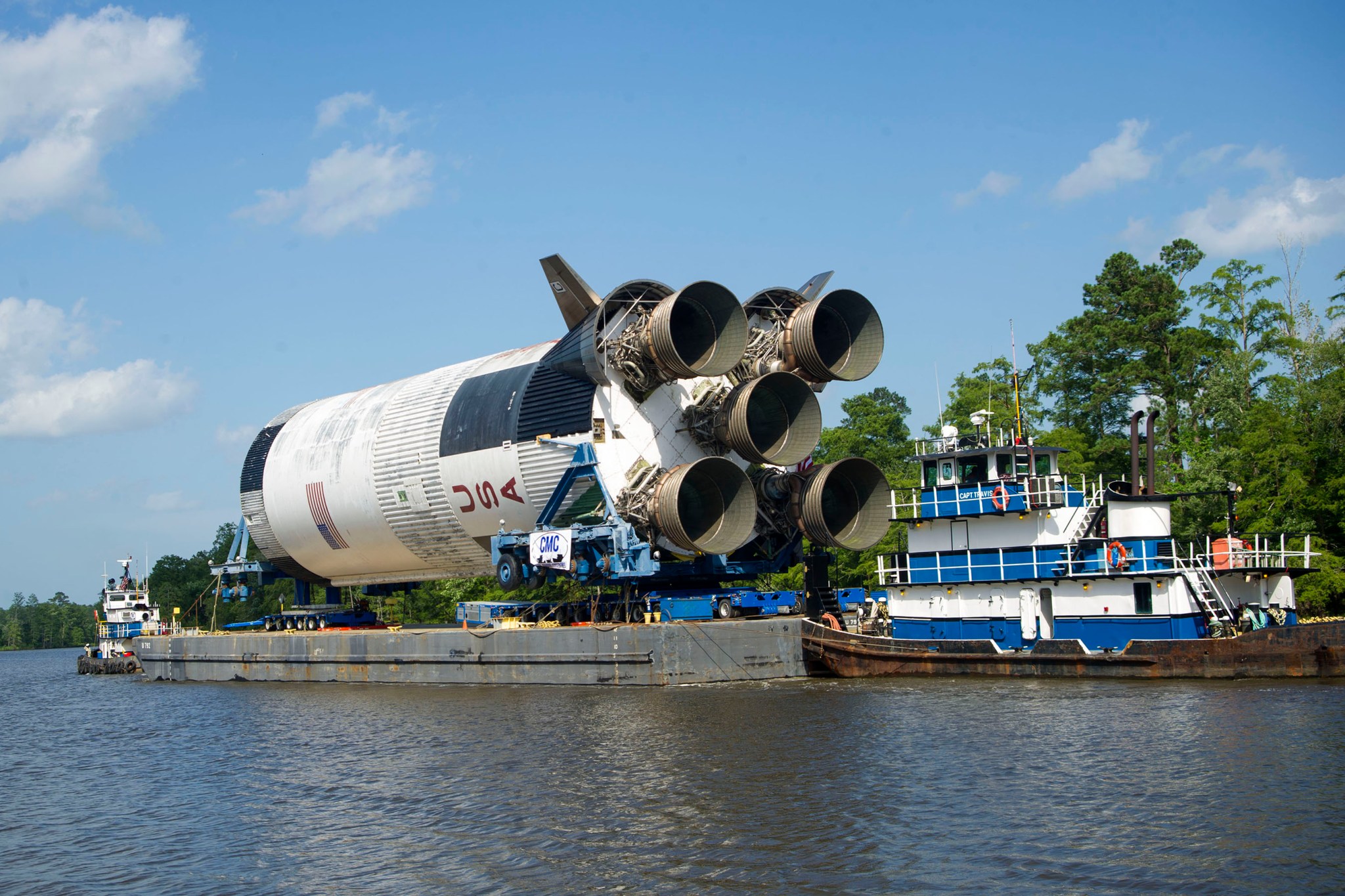History both repeated and foreshadowed itself with transport of the S-IC-15 Saturn V rocket stage to NASA’s Stennis Space Center this month.
It repeated in literal fashion. The stage was transported from NASA’s Michoud Assembly Facility to Stennis Space Center on June 16, via the same water route it took more than 45 years ago to undergo testing at Stennis. On June 20, the stage traveled from Stennis to the INFINITY Science Center for public display.
The move also foreshadowed the future in taking the same route that NASA’s Space Launch System (SLS) first stage will travel next year when it arrives for its own testing at Stennis – on the very same B-2 Test Stand that housed and tested the Saturn V stage.
As if such historical connections are not enough to demand notice of the stage arrival, there also was the sheer spectacle of watching the mammoth rocket stage in transport. The S-IC-15 was one of fifteen Saturn V first stages built during those early years of the American space program. These were the stages that lifted astronauts on Apollo missions to the moon – powerful, towering units that burned like giant candlesticks in the sky during launch.
The S-IC-15 stage now displayed at INFINITY is a prime example of the units. It is 138 feet long (or tall depending on its orientation) and 33 feet in diameter. Empty, it weighs 300,000-plus pounds. Loaded with fuel, it weighs 4.8 million pounds – or 2,400 tons.
Powered by five Aerojet Rocketdyne F-1 engines firing simultaneously, the stage supplied 7.5 million pounds of thrust for two-and-a-half minutes at launch.
Anyone at Stennis on Sept. 30, 1970, heard and witnessed the power of such thrust during the S-IC-15 test firing that lasted a few seconds over two minutes. For the test, the stage was installed in vertical position on the test stand, and all five of its engines were fired at the same time, just as during a launch.
The firing marked the penultimate Saturn V stage test at Stennis. The final test came just a month later when a Saturn V booster stage was fired on the A-2 Test Stand.
Following the Sept. 30 test, the S-IC-15 stage was transported back to Michoud, where it had been assembled. Initially, it was planned for transport across open water to Kennedy Space Center in Florida for use on the Apollo 19 mission.
However, in the fall of 1970, the final three Apollo missions were canceled. Ironically, if the normal rotation process had been followed in assigning crews to those missions, Apollo 19 would have been commanded by Fred Haise, a native of Biloxi, Mississippi, pilot of the Apollo 13 mission that was unable to land on the moon and a longtime supporter of Stennis Space Center and INFINITY.
Instead of undertaking that journey, the stage remained at Michoud until it traveled to
Stennis by water and to INFINITY by specialized transport for display at the science center. There, it symbolizes many aspects of the American space program, including Stennis’ close involvement with the historic lunar missions.
The story of Stennis’ involvement with the nation’s space program has many several chapters, including a new one now being written as the rocket engine site tests the RS-25 engines and SLS stages that will carry humans deeper into space than ever before, to an asteroid and eventually Mars.
RS-25 engines are currently being tested on the A-1 Test Stand. Next year, an SLS first stage will arrive at Stennis for testing. It is even larger and heavier than its Saturn V sister, which has required considerable modification of the B-2 test stand.
Testing of the SLS stage will involve installing it on the test stand and firing its four RS-25 engines simultaneously, generating about 2 million pounds of thrust. Following the test, the SLS stage also will return to Michoud, where it then will break with the repetition of history. Instead of remaining at Michoud, the stage will take the journey denied to S-IC-15. It will be transported to Kennedy Space Center for use on the uncrewed SLS Exploration Mission-1 flight in 2018.
With that launch, NASA will fully enter its new era of exploration, and Stennis Space Center will add to its tradition of powering the nation’s space dreams.
Valerie Buckingham
Stennis Space Center
228-688-3898
valerie.d.buckingham@nasa.gov



























